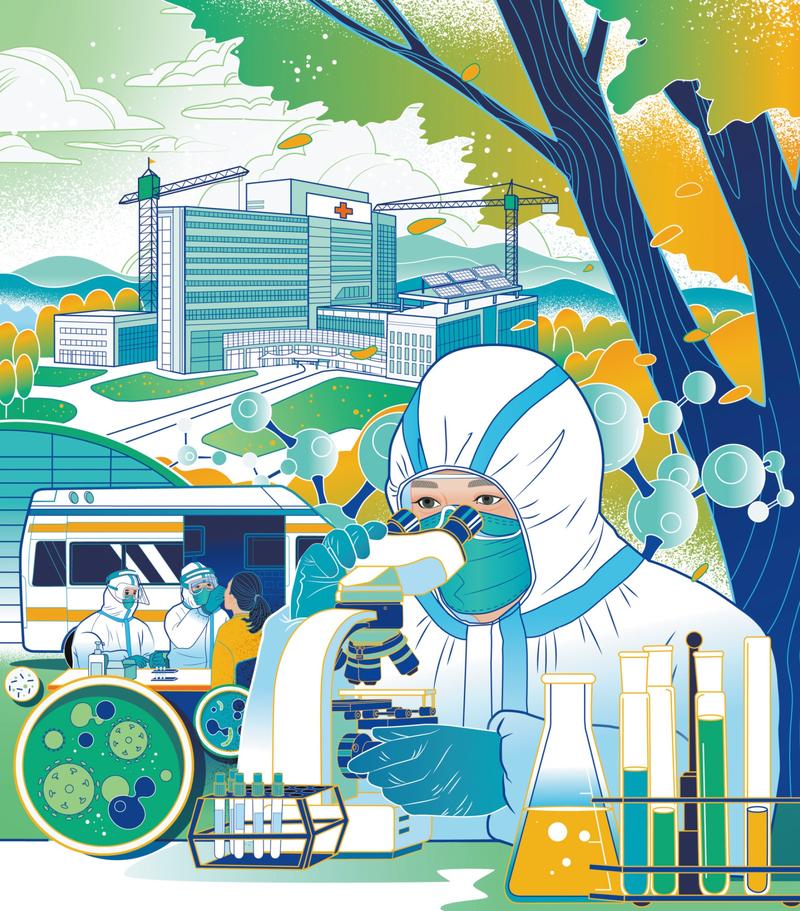Premier says increasing capacity and speed are crucial measures in pandemic containment process
 (SHI YU / CHINA DAILY)
(SHI YU / CHINA DAILY)
The State Council has pledged to bolster China's COVID-19 testing capacity and develop technologies that can produce more accurate results more quickly as the country braces for a possible spike in infections in autumn and winter.
Improving testing capacity will be a key measure in coordinating epidemic containment and socioeconomic development, the Cabinet said after its executive meeting on Wednesday.
It pledged to mobilize the strength of various sectors to speed up the development of testing kits, especially those that are easier to operate, and to accelerate training for staff at testing laboratories. It added that testing capacity must be reasonably distributed in different areas and the number of mobile labs must be increased.
The Cabinet has also set a target of ensuring that testing services can be offered at all top-tier hospitals and infectious diseases hospitals, saying that at least one public hospital in each county across the nation must be able to conduct tests. Authorities at all levels must beef up funding support for testing, it added.
Premier Li Keqiang said at the meeting that, in addition to mask wearing and social distancing, strengthening the country's testing capacity is a crucial measure in the pandemic containment process, and testing kits that can deliver more accurate and quicker results are essential for the early detection of infections.
Officials and experts have warned of a possible spike in the pandemic in autumn and winter, when respiratory infectious diseases are more prone to spreading in clusters.
Wang Hesheng, deputy head of the National Health Commission, told a news briefing on July 28 that the country is gearing up for a possible rebound of the pandemic, including steps to raise the capacity and quality of nucleic acid testing.
China has flattened the curve of the pandemic despite recent spikes in cases in the Xinjiang Uygur autonomous region and Dalian, Liaoning province.
The country increased the number of medical institutions offering nucleic acid tests from 2,081 in March to 4,804 by the end of June, when 3.78 million tests could be conducted a day, double the number in March, the National Health Commission said.
A document issued by the commission last month stipulates that fever clinics must report testing results in six hours, while results for tests conducted on patients at hospitals must be delivered in 12 hours. For individuals who voluntarily undergo testing, institutions must report the results in 24 hours.
The document also called for local authorities to step up training for staff at testing agencies and enable the universal recognition of results to avoid repeat testing.
Wu Ming, a professor of public health policy and administration at Peking University, said targeted testing measures and effective contact tracing have enabled the country to quickly contain fresh outbreaks.
"Preparedness averts peril," she said. "Our knowledge of the novel coronavirus remains incomplete, and we need to ramp up our testing strength to prepare for worse-case scenarios."
Wu added that some areas could lack sufficient qualified personnel if large-scale testing is required, and the problem could be solved by increasing the number of mobile testing centers.
The latest policy has offered another significant boost to the many biotech companies who are researching testing technologies.
Dai Lizhong, the chairman of Sansure Biotech in Changsha, Hunan province, and also a National People's Congress deputy, said an integral part of improving testing technology for COVID-19 is to allow tests to be conducted outside professional labs and to meet the demand emerging in different scenarios, such as at customs posts, airports and grassroots institutions.
Dai's company released a diagnostic system for the coronavirus on Thursday that does not require a professional laboratory and gives a test result within 15 to 45 minutes.
He said the latest Cabinet policy will significantly bolster the testing capacity at primary-level medical institutions and create a strong pillar of infrastructure and technological strength to help contain major disease outbreaks in the future.


